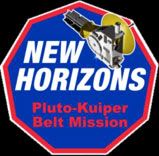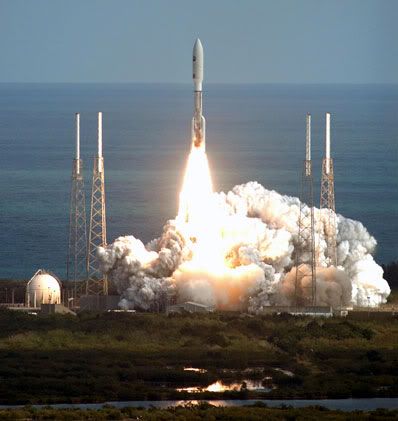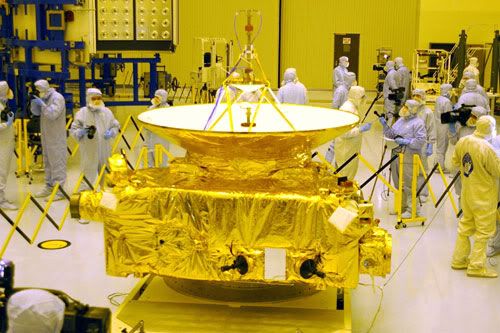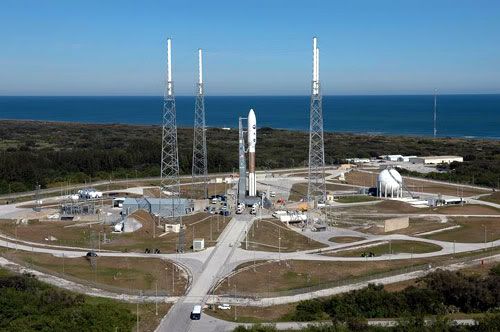
EDIT (January 17): The countdown below is revised to reflect the 10:16 AM (Pacific Standard Time) liftoff time for tomorrow, January 18. However, because of morning showers and more gusty winds that are expected to be in the forecast for Wednesday, there is a huge chance that New Horizons will end up being launched on Thursday, January 19 (when the weather should improve considerably...with acceptable launch conditions improving from 70% expected for tomorrow to 90% for Thursday).
EDIT #2 (January 18): As expected, New Horizons will not be launched today. The liftoff was scrubbed once more when bad weather caused a power outage in the Baltimore-Washington area, where the Mission Control Center for New Horizons is located (at the John Hopkins University's Applied Physics Laboratory). Mission Control was running on backup power, but that is not enough to support critical launch and early flight operations. A decision will be made later today to see if a launch can be attempted tomorrow. If it is, there is an 80% chance of acceptable launch conditions for January 19. The launch window for this day opens at 10:08 AM, PST.
EDIT #3 (January 18): After the main power had been restored at the John Hopkins University in Maryland, NASA officials gave the go-ahead to proceed with another launch attempt for tomorrow, January 19. Tomorrow SHOULD be the day...considering the forecast calls for sunny weather and wind speeds that should be well within the acceptable limits for launching New Horizons. We shall see...


EDIT #4 (January 19): LIFTOFF!

Photo by NASA Kennedy Space Center
17 HOURS, 24 MINUTES AND 59, 58, 57, 56, 55 SECONDS REMAINING... By tomorrow afternoon (if you're living on the East Coast of the United States) or late morning (if you're on the West Coast), the fastest spacecraft ever flown should be off its launch pad in Florida and begin its 9-year journey towards the last(?) planet(?) in our solar system. Yes, those question marks were intentional. Last week, New Horizons underwent the final NASA Flight Planning Board, and passed its Flight Readiness Review...followed by Sunday's Launch Readiness Review...which basically means the Pluto-bound explorer is now officially ready to roar off the ground on 2.5 million pounds of rocket thrust, and start an approximately 50-minute long journey out of Earth orbit. Below is a timeline showing how long each of the Atlas V's engines will burn before running out of fuel and sending New Horizons on its way into deep space. The Atlas V carrying New Horizons actually has three stages (as opposed to two used by past Atlas rockets): The RD-180 first stage rocket motor, the Centaur second stage rocket motor and the Boeing third stage kick motor. The Boeing motor was specifically installed for this flight:
5-24 seconds after liftoff: The RD-180 engine will be ramped down from 100% throttle to 67% to keep maximum dynamic pressure ("Max-Q") to 900 psf (pounds per square foot).
45 seconds after liftoff: The RD-180 will be throttled up to 86% to increase control and performance until ramped down again to 75% throttle to better limit vehicle loads for solid rocket booster (SRB) burnout.
1 minute, 33-45 seconds after liftoff: SRB burnout and separation at an altitude of 23 miles and 0.8 miles-per-second velocity. The RD-180 is then throttled back up to 100%, but adjusted down at specific times to maintain the proper G-force loads.
3 minutes, 23 seconds after liftoff: Fairing jettison at an altitude of 72 miles.
4 minutes, 27 seconds after liftoff: RD-180 shutdown and separation of the Atlas V first stage, followed immediately by Centaur second stage ignition.

ABOVE: At Kennedy Space Center in Florida, the New Horizons spacecraft is put on
display for a media junket back in November of last year. (Photo by Ben
Cooper of LaunchPhotography.com)
10 minutes, 8 seconds after liftoff: Centaur cutoff after placement of the vehicle in a 90 X 115 nautical-mile parking orbit for a coast over the Atlantic Ocean.
32 minutes after liftoff: Centaur re-ignition over southern Africa to begin the Earth escape maneuver.
41 minutes, 45 seconds after liftoff: Centaur cutoff and separation at a velocity of 7.7 miles-per-second and an altitude of 435 miles and climbing.
42 minutes, 37 seconds after liftoff: The New Horizons spacecraft and Boeing upper-stage motor will be spun up to about 80 RPM for stabilization. This will be followed by ignition of the 15,000-lb.-thrust Boeing motor for 88 seconds. Depending upon the launch day, the burn will take place near or over Australia. The spacecraft rotation will be slowed by "yo-yo-weights" after the burn.
47 minutes, 32 seconds after liftoff: The spacecraft, flying at 10.07 miles-per-second, will be separated from the Boeing stage. New Horizon's rotation rate will be slowed to 5 RPM for cruise.
Timeline courtesy of AviationNow.com

Photo by NASA Kennedy Space Center
ABOVE AND BELOW: The Atlas V rocket carrying New Horizons now sits atop its
launch pad, following a rollout from the rocket's vehicle assembly building that took
place at 7:30 AM (Pacific Standard Time) yesterday, January 16. Click here to view the live
webcam feed from Cape Canaveral Air Force Station in Florida ( RealOne Player is
required for viewing).

Photo by Ben Cooper of LaunchPhotography.com

Photo by NASA Kennedy Space Center

No comments:
Post a Comment